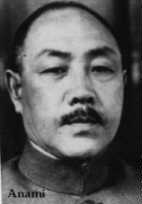

General Anami became the War Minister of Japan in April 1945. As the highest ranking member of the Japanese Army, he was one of the most powerful men in Japan. As War Minister, Anami was a member of Japan's Cabinet (the decision making body of the national government). He was also a member of the Supreme Council for the Direction of the War, known as the Big 6 since it had six members. The Big 6 was highly influential upon the Cabinet.
From the time he became Minister of War, Anami was the leader of those who wished to avoid surrender at any cost. He ordered the arrest of many who dared speak of peace. Surrender was unthinkable to him; he has been called "the very model of a modern samurai" (Lester Brooks, "Behind Japan's Surrender", pg. 44).
With a string of major battle losses and the U.S. destruction of Japanese cities from the air during 1945, Japanese leaders agreed that a new approach to the war was needed. Some sought to end the war. But for Anami, this meant staking all on a great decisive battle on the Japanese mainland in which Allied casualties would be so high that Japan could escape surrender and perhaps even keep her conquests.
The Hiroshima and Nagasaki atomic bombs and the Soviet Union's declaration of war on Japan failed to sway Anami. He demanded that Japan "must fight to the end no matter how great the odds against us!" (John Toland, "The Rising Sun", pg. 910) unless four conditions were accepted by the Allies:
Anami's arguments were overcome by a request from Japan's Emperor Hirohito for an immediate end to the war. Those who wished to continue the war suggested that Anami vote against surrender or resign from the Cabinet, either of which would have stopped the surrender, or support a rebellion against the government. Instead, Anami told his officers to obey the emperor's wish. He confided his reason to his brother-in-law: "As a Japanese soldier, I must obey my Emperor" (Pacific War Research Society, "Japan's Longest Day", pg. 87-88). He signed the surrender document along with the rest of the Cabinet. Then early the next morning on Aug. 15, 1945 he committed hara-kiri.
- Doug Long
For further information:
Lester Brooks, Behind Japan's Surrender (biography on pg. 43 - 50)
Robert Butow, Japan's Decision to Surrender
Dan Kurzman, Day of the Bomb (biography on pg. 231 - 240)
Pacific War Research Society, Japan's Longest Day
John Toland, The Rising Sun
To return to the Who's Who and What'd They Do? index, click Who's Who (http://www.doug-long.com/who.htm)
To return to the Hiroshima: Was it Necessary? home page, click Home Page (http://www.doug-long.com)